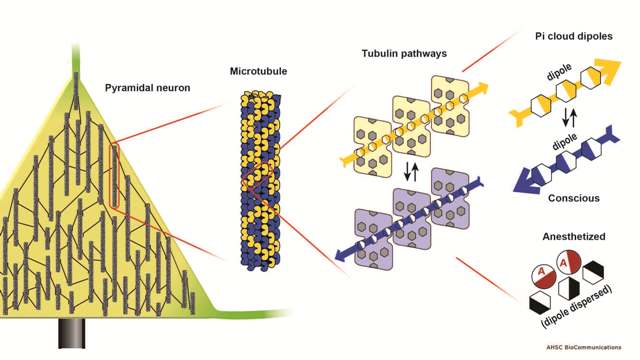Mar 25 2015
Oil and water don’t mix. Can that simple fact explain consciousness? In a special issue of 'Current Topics in Medicinal Chemistry’ scientists from Nova Southeastern University, the University of Alberta and the University of Arizona find evidence that anesthetics act to prevent consciousness in non-polar, oil-like ‘quantum channels’ deep inside proteins, deep inside brain neurons.
 Brain hierarchy leads inward to quantum channels where anesthetics act to prevent consciousness. Illustr: Paul Fini, Dave Cantrell, Biomedical Communications, University of Arizona, Center for Consciousness Studies, Anesthesiology, Banner-University Medical Center
Brain hierarchy leads inward to quantum channels where anesthetics act to prevent consciousness. Illustr: Paul Fini, Dave Cantrell, Biomedical Communications, University of Arizona, Center for Consciousness Studies, Anesthesiology, Banner-University Medical Center
Anesthetic gas molecules selectively prevent consciousness, sparing non-conscious brain activities. But where, and how? At the turn of the 20th century, Meyer and Overton found that potency of various anesthetic gases correlated precisely with their solubility and binding in a non-polar medium akin to olive oil, later shown to be largely pi electron resonance clouds of ‘aromatic’ amino acid rings within brain proteins. Shielded from the polar environment, pi cloud arrays in photosynthesis proteins support quantum coherence. Could anesthesia block consciousness by preventing quantum coherence in brain proteins? Which proteins?
After decades of inconclusive study of membrane receptor proteins, evidence for anesthetic action now points instead to a deeper level inside neurons, in non-polar regions inside the protein walls of cytoskeletal microtubules.
Microtubules are protein lattice polymers which organize neuronal interiors and regulate synapses. Several theories suggest consciousness depends on microtubules acting as quantum computers whose quantum bits (‘qubits’) involve coherent dipole couplings among pi electron resonance clouds.
Using molecular modeling, the US-Canadian team of Travis Craddock, Stuart Hameroff and Jack Tuszynski had previously shown anesthetic binding in ‘quantum channels’, non-polar arrays of amino acid pi resonance clouds, winding through microtubules.
In the present study, the team modeled dipole-coupled oscillations between benzene ring pi resonance clouds and found intrinsic coherence at a frequency of 68 Terahertz (68 x 1015 Hz). With a nearby anesthetic molecule binding by van der Waals ‘dipole dispersion’ forces, the energy barrier increased, changing the clocking frequency by 20 percent. Thus anesthesia may dampen terahertz vibrations in quantum channels in brain microtubules. How would that cause loss of consciousness?
Travis Craddock, lead author said: ‘The brain is looking like a scale-invariant hierarchy, with clocking frequencies at different spatio-temporal scales – clocks within clocks within clocks…. Anesthetics act at the deepest level, the fastest clock, the inner apex of a brain hierarchy in which consciousness occurs.